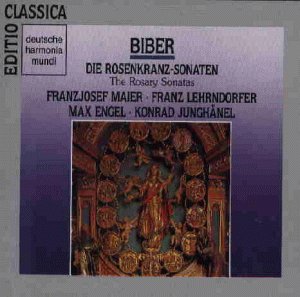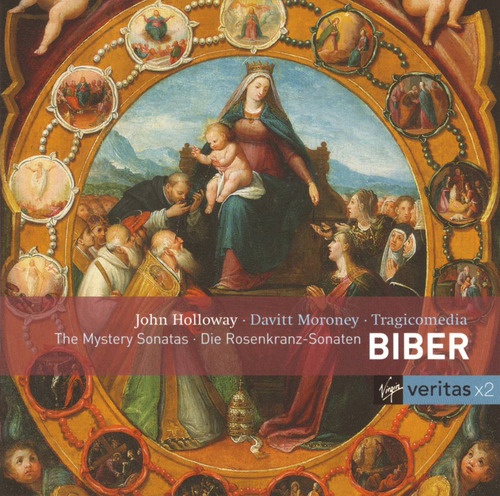Biber The Mystery Sonatas
View record and artist detailsRecord and Artist Details
Composer or Director: Heinrich Ignaz Franz von Biber
Label: Editio Classica
Magazine Review Date: 5/1991
Media Format: CD or Download
Media Runtime: 144
Mastering:
ADD
Catalogue Number: GD77102

Tracks:
| Composition | Artist Credit |
|---|---|
| Mystery (Rosary) Sonatas and Passacaglia |
Heinrich Ignaz Franz von Biber, Composer
Franz Lehrndorfer, Organ Franzjosef Maier, Violin Heinrich Ignaz Franz von Biber, Composer Konrad Junghänel, Theorbo Max Engel, Cello |
Composer or Director: Heinrich Ignaz Franz von Biber
Genre:
Chamber
Label: Virgin Classics
Magazine Review Date: 05/1991
Media Format: CD or Download
Media Runtime: 131
Catalogue Number: 562062-2

Tracks:
| Composition | Artist Credit |
|---|---|
| Mystery (Rosary) Sonatas and Passacaglia |
Heinrich Ignaz Franz von Biber, Composer
Davitt Moroney, Organ Heinrich Ignaz Franz von Biber, Composer John Holloway, Violin Tragicomedia |
Author: Nicholas Anderson
As well as being a gifted composer Biber was a celebrated violin virtuoso and his writing for the instrument is both technically advanced and strikingly individual. All but one sonata in the set require scordatura or re-tuning of the violin strings; in that way Biber not only facilitated some fingerings but also achieved sonorities otherwise unavailable to him—the First Sonata alone calls for standard tuning. As for the music itself, it is for me an exuberant blend of Italian influences with south German baroque flamboyance.
The manuscript containing the Mystery Sonatas is an interesting one not only for the music itself but also for the inclusion at the head of each work of a small, circular copper-plate engraving depicting the particular event which inspired each piece. These charming roundels are reproduced in the Virgin booklet, 16 in all since one belongs to the unaccompanied Passacaglia in G minor with which Biber concludes his opus. This absorbing piece, like the opening sonata calls for normal violin tuning in fifths. Biber furthermore disposes the sonatas into three groups of five: Joyful, Sorrowful and Glorious Mysteries respectively.
There have been four previous recordings of Biber's Mystery Sonatas that I know of but, to date, John Holloway with a first-rate continuo group outstrips them all. He is, quite simply, more responsive to essential details in Biber's writing making those very contrasts which go hand-in-hand with baroque art. In this respect Franzjosef Maier fails badly, playing the entire set at approximately the same robust dynamic level. Lautenbacher (her Vox set—9/64—has been reissued in a two-CD album on Pantheon (CD) D20783—not currently distributed in the UK) is more impressive and is fortunate in her continuo players. Melkus (Archiv Produktion, 8/68—nla) captures the southern baroque exuberance better than either, but his fantasy is apt to fly in the face of convincing aspects of style. Holloway seems to me to possess the combined merits of these players while sharing few if any of their defects.
These are deeply felt performances, full of sensibility and variously tender and passionate as the subject and music require. Holloway allows the music to breathe enabling the listener to explore every detail in Biber's intricate writing. He is as attentive to nuances of pitch, interval and rhythm as he is to occasions such as those which, for instance, occur in the Seventh Sonata, where Biber specifically illustrates the text—here it is the Scourging of Jesus which is portrayed with biting reiterated figures. Sometimes, I feel that he does not sufficiently respond to the joyful side of the music; the richly inventive Aria with Variations over a 30-times-recurring ostinato from the Sonata No. 14 (''The Assumption'')—one of Biber's greatest achievements in the set—is a little lacking in fervour. Nevertheless, this, along with almost everything else here, is played with style and finesse.
Finally, a word about the continuo group which would be hard to improve upon. Davitt Moroney divides his time between a fine sounding chamber organ and harpsichord while the personnel of Tragicomedia field a variety of instruments: baroque lute, chitarrone, viola da gamba, lirone (in this instance a 15-stringed instrument), double harp and a pleasingly assertive regal. Biber did not specify these instruments but he would have called upon some if not all of them if and when he performed the music himself. In sum, a richly rewarding issue, thoughtfully approached, affectingly realized and beautifully recorded. A satisfying and important release.'
Discover the world's largest classical music catalogue with Presto Music.

Gramophone Digital Club
- Digital Edition
- Digital Archive
- Reviews Database
- Full website access
From £8.75 / month
Subscribe
Gramophone Full Club
- Print Edition
- Digital Edition
- Digital Archive
- Reviews Database
- Full website access
From £11.00 / month
Subscribe
If you are a library, university or other organisation that would be interested in an institutional subscription to Gramophone please click here for further information.




